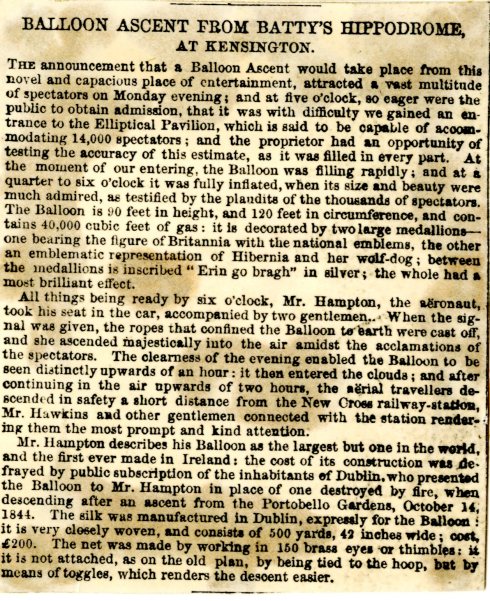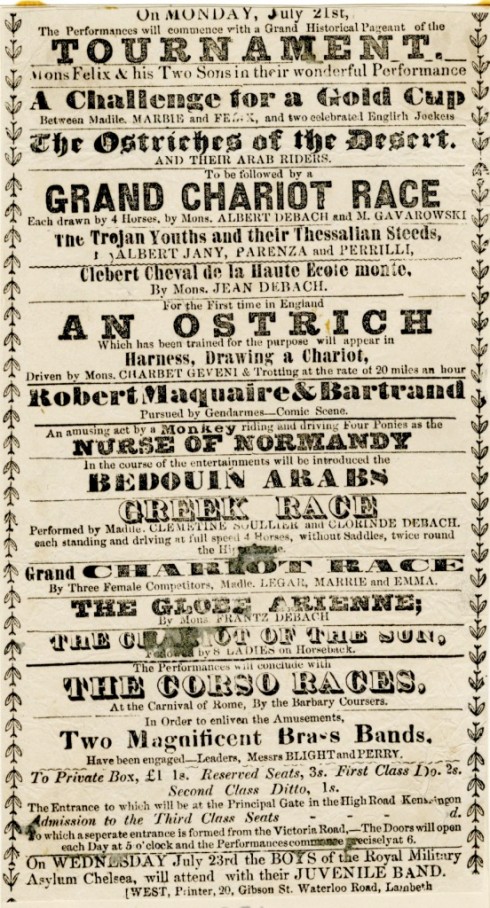BATTY'S HIPPODROME

WITHIN five minutes' walk of the Crystal Palace, Mr. Batty has erected a novel kind of circus, calculated to be a rival to his own Astley's, but for the difference of locality and aim. Opposite the Broad-walk, Kensington Gardens, an amphitheatre of enormous dimensions, under the title of "the Hippodrome," attracts all lovers of horsemanship. It consists of a circle of boxes and stalls divided by two opposite orchestra stations, which are occupied by two brass bands, who continue playing during the performance and an hour previous. The seats for the audience are covered, but the arena for Equestrian exhibition is open to the air and sky. We are thus carried back to the ancient times of Greece and Rome, and our own Elizabethan era; and the entertainments are suitable to these classical associations. Tournaments, chariot races, Trojan youths and Thessalian steeds, and such reproductions from the days of old, are the prevailing amusements. We believe, indeed, that the bills attempt no delusion in stating, that these exercises are "on a scale of extent and grandeur hitherto unattempted in England." The artists have been drafted from the Hippodrome at Paris, the principal being M. Louis Soullier, equerry to his Highness the Sultan Medjid of Turkey and the Emperor of Russia, and "his numerous and highly-trained stud of horses" to whom may be added his company. The performance on Wednesday commenced with a pageant representing the meeting of Henry VIII. and Francis I. on the Field of the Cloth of Gold . . . The second part was not less interesting. The Brazilian coursers, performed by the three brothers Debach, on four horses each, was a highly exciting scene - presenting a trial of skill emulously carried out. But this was exceeded in interest by that exhibited by three female competitors, in a grand chariot race. The performances concluded with a monkey riding and driving four ponies; dames of the chase, in characteristic costume, on leaping palfreys; M. Frantz Debach, on the glove arienne, a well-known but difficult feat, and in this instance executed with inimitable grace; and the Corso races by Barbary coursers, as exhibition at the Carnival of Rome. We have omitted to mention an exceedingly amusing race by two ostriches of the desert, with their Arab riders, one of whom was thrown in the experiment.
Illustrated London News, Jan.-June, 1851

In the autumn of 1850, William Batty, a famous circus proprietor, acquired some land within five minutes walk of the new world-wonder, the 'Crystal Palace,' and erected thereon an elliptical-roofed pavilion which accommodated many thousands of spectators, and had a large arena open to the sky.
The Royal Hippodrome was opened in May 1851 with a French troupe brought over from the Hippodrome at Paris. The performances generally took place in the evening, and the lowest price of admission was sixpence. Two brass bands of a rather blatant character enlivened the proceedings. Favourite features of the entertainment were a Roman chariot race and a 'triumphal race of the Roman consuls', who were represented by the three brothers Debach, each guiding six horses. . . . Other attractions were balloon ascents, and F.Debach's journey on the Arienne Ball up and down a narrow inclined plank.
The Hippodrome closed with the [Great] Exhibition and only lived for one other season in 1852. Subsequently in the sixties it was used as a riding school. The site lay nearly opposite the broad walk of Kensington Gardens, between part of Victoria Road and Victoria Walk and the present Palace Gate. De Vere Gardens mainly occupy the site.
Warwick Wroth, Cremorne and the later London Gardens, 1907


The handbills promised some marvelous equestrian and musical displays.
All set in a splendid new arena, built to contain these wonders.

No comments:
Post a Comment